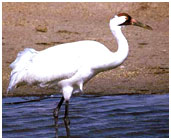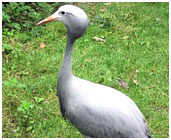Crane is a beautiful bird found occupying almost all the countries of the world. In this article, we have provided a number of interesting facts about cranes, along with some amazing information.
Facts About Crane
A Crane is a large bird, which is mainly characterized by its long legs and a long neck. It looks quite similar to the heron bird, though the two species are not at all related to each other. Under the four genera of cranes, one can count as many as fifteen species of the bird. Cranes are majestic looking birds and have become critically endangered as a result of chronic habitat loss. Some of these species are not at all endangered, while some are at the brink of extinction such as the Whooping Crane, the Sandhill Crane and the Common Crane. Cranes can be found almost in all parts of the world, though the species might differ. The most common places where you are likely to find a large number of cranes are in America, East Asia and Africa. They are opportunistic feeders and eat according to the season and their body requirements. In case you want to know more about the beautiful bird, make use of the amazing and interesting information provided in the following lines.

Fast Facts
Kingdom: Animalia
Phylum: Chordata
Class: Aves
Order: Gruiformes
Family: Gruidae
Genera: Four (Grus, Anthropoides, Balearica and Bugeranus)
Height: up to5 feet
Weight: 4-12 kg
Wingspan: up to 7 feet
Age: 20 to 25 years
Natural Habitat: All the continents, except Antarctica and South America
Diet: Omnivorous
Number of Eggs: Two
Sexual maturity (male): 3-5 years old
Sexual maturity (female): 4-5 years old
Status: Endangered
- The diet of a crane varies; depending upon the species, but usually includes small rodents, fish, amphibians, insects, grain, berries and plants.
- Amongst the endangered species of cranes are Whooping Crane, Florida Sandhill Crane, Siberian Crane and Mississippi Sandhill Crane.
- Cranes are monogamous birds, which usually remain with a single mate, till either of them dies.
- Hunting and habitat destruction comprise of the biggest threats to the population of cranes.
- The feet and legs of a crane work in conjunction with the crane’s beak.
- Have you ever wondered how cranes can stand for hours in near-freezing water? This is because, they have the ability to constrict blood vessels in their feet, thereby reducing blood flow.
- Cranes are social birds, which are usually found living within large flocks.
- All the species of cranes have been protected by international agreement.
- Eurasian Crane is the highest flying crane, reaching an altitude of approximately 32,800 feet.
- The rarest species of cranes is the Whooping Crane, whose population has gone down to less than 500.
- Cranes attack aggressors with their feet.
- Whooping cranes have been known to fly as far as 500 miles in a day.
- In some areas of Asia, a few species of cranes are considered to be sacred.
- It has been seen that cranes usually build their nests in marshy areas.
- The elongated trachea of a crane enables it to produce sounds that can be heard at great distances.
- Cranes rely on tail winds and thermals (rising columns of warm air) to help them during their flight.
- The Platte River region is recorded as the most ideal stopover for migrating cranes. This region supports a variety of habitats for cranes and also provides the perfect spot for rest and food.
- During the period of mating. Cranes take part in an elaborate dance, involving fast steps, tall leaps, stretching and even bowing.
- The chicks of a crane grow very quickly and develop their flight feathers within 2-4 months of being born.
- Cranes use different types of calls for the purpose of communication. They also follow a fairly elaborate system of body language, for the same.
- The chicks of whooping cranes sleep standing up.
- Migratory cranes begin nesting from early April to late May. Non-migratory folk begin nesting from December to early March.
- Sandhill cranes get their red crown only after they reach the age of 7 months.
- Fossils of Sandhill Crane, dating back to 6,000 years ago, indicate it to be the oldest species of bird alive.
- Today, there are just about 15 species of cranes in the world.
- Whooping cranes have 20 bones in their necks and have been named so for their loud, bugle-like call.


See also
More from iloveindia.com
- Home Remedies | Ayurveda | Vastu | Yoga | Feng Shui | Tattoos | Fitness | Garden | Nutrition | Parenting | Bikes | Cars | Baby Care | Indian Weddings | Festivals | Party ideas | Horoscope 2015 | Pets | Finance | Figures of Speech | Hotels in India : Delhi | Hyderabad | Chennai | Mumbai | Kolkata | Bangalore | Ahmedabad | Jaipur
- Contact Us Careers Disclaimer Privacy Policy Advertise With Us Lifestyle Sitemap Copyright iloveindia.com. All Rights Reserved.



